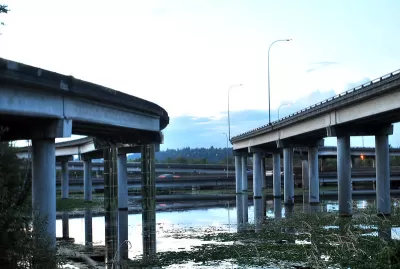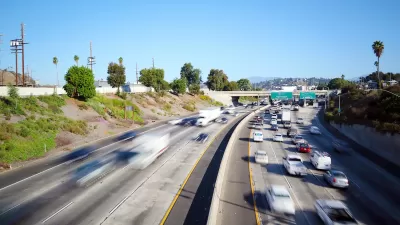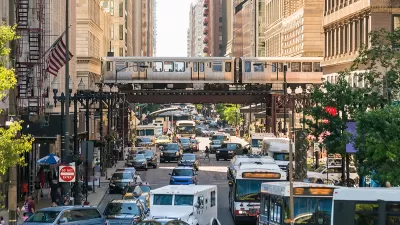The history of Seattle's opposition to car infrastructure is being commemorated while it's being made.

Knute Berger and Stephen Hegg write to update the history of Seattle's "ramps to nowhere"—the vestiges of the city's mid-20th century freeway building binge that came to a halt in a wave of environmental activism in 1972.
The most famous example of ramps to nowhere, and the subject of this exploration, are the remnants of the R.H. Thomson Expressway.
R.H. Thomson Expressway on and offramps had been built when the Evergreen Point Bridge — the State Route 520 floating bridge — was built in the early 1960s. They just sat waiting for the expressway to be attached. But they stood unconnected, like ancient ruins or garden follies. Instead of carrying cars, kids would jump off them into Lake Washington during warm summer days. They were used by swimmers and sunbathers. They were very expensive diving boards.
As noted by Berger and Hegg, the R.H. Thompson Expressway ramps to nowhere have taken on a symbolism attached to the civic activism that halted construction of the project. In the past, residents have advocated for the preservation of the ramps to commemorate those efforts. According to the article, one ramp will remain standing for that purpose, but the rest are coming down.
In a bit of synchronicity between past and present, the city of Seattle is currently debating the need to expand some of its existing bridges for cars, as highlighted in a separate article by the editorial board of The Urbanist. The Magnolia Bridge, "[s]erving a peninsula with some 20,000 residents and two other bridges over the Interbay railyard," is the perfect example of the tendency for elected officials in Seattle to push for car infrastructure as a matter of regional and even national priority (in that way, Seattle-area politicians certainly resemble politicians in other corners of the country). Clearly, the editorial board of The Urbanist aims to follow in the footsteps of their anti-highway forebears.
FULL STORY: An end to Seattle’s ramps to nowhere

Planetizen Federal Action Tracker
A weekly monitor of how Trump’s orders and actions are impacting planners and planning in America.

Congressman Proposes Bill to Rename DC Metro “Trump Train”
The Make Autorail Great Again Act would withhold federal funding to the system until the Washington Metropolitan Area Transit Authority (WMATA), rebrands as the Washington Metropolitan Authority for Greater Access (WMAGA).

DARTSpace Platform Streamlines Dallas TOD Application Process
The Dallas transit agency hopes a shorter permitting timeline will boost transit-oriented development around rail stations.

Single-Stair Design Contest Envisions Human-Scale Buildings
Single-stair building construction is having a resurgence in the United States, where, for the last several decades, zoning codes have required more than one staircase in multi-story housing developments.

Tesla Protests Release of Documents About Austin Robotaxi Launch
The company seeks to block the release of emails with city officials on the grounds they could contain confidential information and trade secrets.

Fungi to the Rescue: How Mushrooms Are Helping Clean Up Toxic Lands
Fungi are emerging as powerful tools in environmental cleanup, with scientists and community leaders using mushrooms to break down pollutants and restore contaminated soil.
Urban Design for Planners 1: Software Tools
This six-course series explores essential urban design concepts using open source software and equips planners with the tools they need to participate fully in the urban design process.
Planning for Universal Design
Learn the tools for implementing Universal Design in planning regulations.
City of Charlotte
Municipality of Princeton
Roanoke Valley-Alleghany Regional Commission
City of Camden Redevelopment Agency
City of Astoria
Transportation Research & Education Center (TREC) at Portland State University
US High Speed Rail Association
City of Camden Redevelopment Agency
Municipality of Princeton (NJ)





























